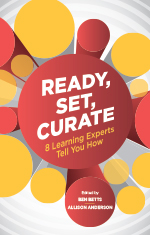ATD Blog
L&D Enters the Age of Curation
Mon Dec 07 2015

In 2006, I pursued my master’s degree at the University of Liverpool (UK). At that time, I was always met with a slight look of disbelief when I said the whole program was taught “online.” This was just after the age of certificate mills, in which fake universities pumped out certificates for non-existent courses. I knew what they were thinking: Was it easier than the traditional classroom? Was it less rigorous? Was my online course even real?
Simply stated, online learning used to be like online dating; it was weird.
Today, of course, online learning is very much mainstream. We forget how far we’ve come—and how fast. It’s estimated that U.S. companies spend $160 billion per year on training and development. E-learning is the fastest growing segment of this expenditure, with an average increase of 23 percent year-on-year. In other words, online learning is a phenomenon.
But it remains expensive. On average, it’s said that to develop one hour of e-learning content costs approximately $30,000. If you were to apply that back to my online degree, it would mean spending $4.5 million per module, just to develop the content for the curriculum.
The L&D industry has spent a lot of time and effort to try and bring down this figure for content production—with limited success. What’s more, people are starting to question why we’re so focused on content anyway?
Focusing on Content and Systems
You see, even though we’ve been through a digital revolution, our thinking has not changed much since the industrial age. Our focus on consuming content as the sole means of learning is very much a byproduct of past eras.
In fact, the industrial age and the rise of big business gave us the requirement for standardization. With standard processes—standard tools carried out by people proficient to the same standard—the better the content, the more efficient the worker. We even coined a term for the process: the learning curve.
But this content focus is part of bygone era—a Taylorist philosophy that promoted efficient bureaucracy. To the bureaucrats, online learning is a dream. It has the potential to scale infinitely, and to make the administrator’s life better. Students come and go, but administrators remain.
In essence, this means that we focus on making technology that is good for the system, but not so good for the learner. Indeed, our systems are consistently seen as more important than the individuals within them.
This way of thinking isn’t going to work anymore. Work is no longer standard. When you go to work you solve novel problems every day, and memorizing a textbook will not help you to perform a non-standard job. The world changes too fast to document it and commit it to memory.
Teaching the same standard content from the same standard curriculum, year after year, will not help learners. Bottom line: overloading learners with content will not help them.
Adding Context to Online Learning
In the digital age, we are content rich but context poor. Content is no longer king. Welcome to the age of context.
Your superpower in the age of context is to seek out content, to make sense of it, and to share your understanding with others. Your ability to perform this task will dictate your success. Making sense of content for your particular context is your unique skill, and this makes you a curator.
Peter Senge said “Through learning, we re-perceive the world and our relationship to it.” He might as well have said, “Through curation, we re-perceive the world and our relationship to it.” Digital curation is the process of seeking out new ideas, making sense of them for your context, and sharing your findings with the world.
Harold Jarche calls this “Seeking, Sensing, Sharing.”
You “seek” out relevant content; other people’s work.
You contrast it with your own experiences and the realities you face in your world. You make “sense.”
You “share” that new story of how content applies to your context with others.
Seeking, Sensing, Sharing. That’s what work is today.
If You Teach, You Are a Curator
Did you ever notice just how much you learn when you teach? That’s because the sense-making process has real value—not just to others, but to you, as the teacher. And the skill that it takes to make sense of something new is increasingly in demand.
It’s tough to be the translator of ideas, though. So you need to share that process with your students. It’s not on you to make a story so simple that people will just swallow it wholesale; it’s your job to let others make sense of content for themselves.
It will not be enough to simply “know the right answers” in the future world of work. Right answers are easy. Right answers are automatable. Anything that has a binary, yes/no answer will be automated. Future careers will all be about making sense. Your career is at the intersection of making sense out of other people’s ideas. Your life is about making meaning.
Curators don’t ask, “How does it work?” Curators tell others: “This is how it could work.” That means that curation will always be a human process. Tools may help us seek and content may inspire us, but no single piece of content or process can tell you what to think. You must decide that for yourself.
Online learning has been with us for 20 years, but the revolution has only just begun.

To explore this topic further, check out Ready, Set, Curate. This new ATD Press book shows you how to elevate the most important content from an endless sea of learning information and offers strategies to better connect with your audience. Using case studies and relevant examples, eight curation experts share tips and best practices for creating a curation strategy and collecting content that is relevant to your learning communities.
More from ATD
